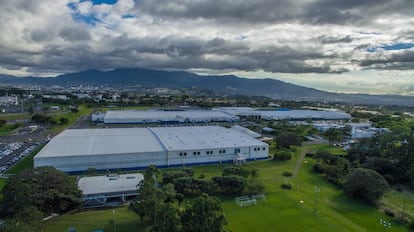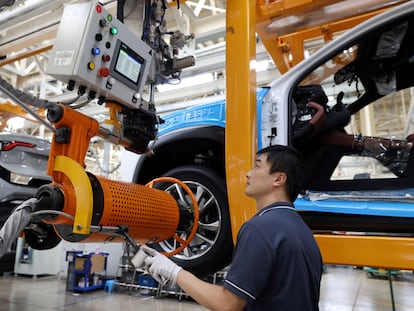From San José to Silicon Valley: Costa Rica is emerging as a hotbed for US chips
Nurtured by Washington, multinationals and universities, the small Central American country is on its way to becoming a hub for integrated circuits

In April 2014, news agencies reported this piece of breaking news from the multinational technology giant Intel: “Chipmaker Intel is closing its assembly and test operation in Costa Rica and eliminating 1,500 jobs (...) It will move its operations from its site in Heredia, where it has been present since 1997, to existing sites in China, Malaysia and Vietnam.” Intel’s operations in the Central American country would subsequently be confined to global services and research and development. But 10 years later, the situation has gone into reverse mode, something not even Intel itself could have predicted.
All efforts are now focused on making Costa Rica a semiconductor industry ecosystem that will attract investment and train young people in technology. This may help mitigate the U.S. government’s current concerns over its enormous dependency on Asian countries for the production of integrated circuits that are essential to digital devices and connectivity; a reliance that Washington believes threatens its national security.
As trade wars between the U.S. and China got underway, not to mention the effects of the pandemic on digitalization and global logistics chains, Costa Rica saw Intel’s manufacturing plant reopen in 2021, an initial sign that the wind was about to change. Now, the development of semiconductors on Costa Rican soil is nurtured by promises of investment and ambitions that go beyond Intel.
Circumstances and its own trajectory are putting Costa Rica on the road to becoming the continental hub for semiconductors, an ambition nurtured by the U.S. government and big players in the industry, together with universities convinced that the country has the right conditions for such an ecosystem to thrive.
“It feels like a different climate,” says David Herrera, an electronic engineering student at the Technology Institute in Costa Rica who already has a contract to work with Intel when he graduates next year. “There are things happening that will open doors within companies and that is motivating. There is a lot of demand for professionals and an interest in training more people.” Herrera is the son of a beekeeper and a housewife, and grew up in an agricultural town called Naranjo, in the west of Costa Rica’s Central Valley, with his education completed exclusively at public institutions. Now, at the age of 23, he is preparing to start working on the functionality on integrated circuits — a far cry from honey production.
The government roadmap
Young people like Herrera were on President Rodrigo Chaves’ mind during his visit to a school in a region of banana plantations. “Who wants to carry bunches of bananas rather than go to work in a microprocessor factory producing the world’s most in-demand technology?” the president asked teenagers a week after presenting the country’s roadmap for the semiconductor industry in the capital, San José, in the presence of U.S. Secretary of Commerce Gina Raimondo and commander of the U.S. Southern Command, Laura Richardson, who was on her third visit since Chaves took office in 2022.

The Costa Rica roadmap consists of creating platforms to stimulate the numbers of professionals and technicians, together with measures to strengthen intellectual property standards, reduce bureaucratic procedures and relax immigration rules to attract specialized personnel. This was announced by the government in parallel with a decree of national interest on the semiconductor industry. Meanwhile, universities are tweaking their curriculums and organizing job fairs with a particular focus on technology. And Intel underpins the $1.2 billion investment announced in 2023 for the plant in Costa Rica, which works 24 hours a day producing half of the company’s total chips globally. There is a lot going on, but training is the key.
“The country has 11,000 professional and technical people graduating each year with skills relevant to the industry, a considerable figure for a country of 5 million inhabitants. Professional graduates are growing at an annual rate of 8.3% and technicians by 20%,” said Foreign Trade Minister Roberto Tovar, before stressing that there is, however, a shortage of personnel to meet current demand.
However, an initiative has been launched to create a center of excellence under the auspices of the Ministry of Science, Innovation, Technology and Telecommunications (Micitt) together with the National Learning Institute, a state entity for technical training and certification in subjects ranging from baking to cybersecurity. The goal is to offer classroom and virtual programs in everything from semiconductors to AI, the cloud and 5G networks; an alliance was forged with 10 multinational companies to build the curricula. “If we count the entire contribution from the multinationals and the academic center, the amount exceeds $47 million,” Micitt Minister Paula Bogantes told the weekly El Financiero regarding plans to try to replicate the development achieved in the last 15 years by the local medical supply industry — the country’s main export product, representing 42% of total exports. This week, the Universidad Latina de Costa Rica announced the first semiconductor certification in Central America for engineers and professionals.
Given the 25-year influence of Intel’s presence in Costa Rica and the arrival of other semiconductor companies, the country is taking significant strides forward, Tovar told U.S. officials. Following the launch of the Joe Biden Administration’s CHIPS Act, Costa Rica was the first to be chosen as a safe country for massive U.S. investment in the industry. “Costa Rica is in the heart of the Americas, between two seas and close to our main market, which means great cost savings,” Tovar told the U.S. authorities. In an era of nearshoring, the fact that there are just over 1860 miles, or a three-hour flight, between the two countries translates into added value.
“Costa Rica has the support of the entire U.S. government,” said U.S. Secretary of Commerce Raimondo. “Right now, the semiconductor industry is concentrated within a few countries globally, and this makes us feel insecure.” Ninety percent of the most sophisticated semiconductors are produced by a single country, 70% of all chips are packaged in Asia and almost 40% in China, she said, hence, the unprecedented investment in an industry destined to double in five to 10 years due to AI.
Chaves is clearly buoyed by Washington’s vote of confidence and the support for the development of the 5G network that has disconcerted China. It distracts from any public focus on the deterioration of the public education system and the subsequent difficulties of finding employment. The State of the Nation Program, a think tank and research center funded by state universities, flagged up the need to increase public investment in research and development (R&D) so that business drive matches knowledge, production, and talent in an inclusive manner. “Costa Rica still does not provide the optimal conditions to support a mature ecosystem to sustain entrepreneurial R&D activities,” it said last September, referring to the medical device sector.
But this could now change, according to the government’s stated objectives, which are music to the ears of investors, as John Neuffer, president of the Semiconductor Industry Association (SIA), pointed out. He noted that Costa Rica is now “a critical link in the supply chain” and that there is “a direct line between Silicon Valley and San José.” Speaking on the government television network, Tovar said the goal is to emulate the established tech mecca in San Francisco so that high-tech businesses will be Costa Rica’s economic engine in the near future. “It’s about going beyond the things that have helped us up to now like agricultural products, beverages and fruits to climb up the value chain,” Chaves explained, in what could have been a direct reference to the Herrera family’s leap from honey making to chips.
Sign up for our weekly newsletter to get more English-language news coverage from EL PAÍS USA Edition









































